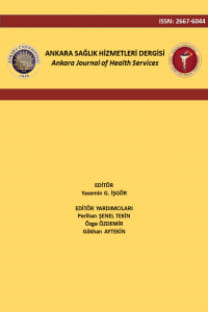Veteriner Tıp Bakışından COVİD-19 Pandemisi
Halen dünyada etkinliğini gösteren COVID-19 pandemisi 2019 yılının sonunda ilk defa Çin'in Wuhan kentindeki canlı hayvan pazarından yayıldığı bildirilen ve zoonotik kökenli bir salgındır. Pandemilerde en önemli adım hastalığın birincil kaynağının bulunması ve kontrol altına alınmasıdır. Ancak ne yazık ki şimdiye kadar ara konakçı olarak hiçbir hayvan türü tanımlanamamıştır. Doğal konağın ise yarasalar olduğu bilinmektedir. COVID-19 hastalığının tüm dünyaya yayıldığı dönemde dünyanın çeşitli yerlerinden gelen bildirimler Covid-19'dan muzdarip insanlarla temas halindeki hayvanların da enfekte olduğunu göstermektedir. Bu yayında dünya genelinde evcil ve yaban hayvanlarında bildirilen COVID-19 vakaları derlenmiştir.
Anahtar Kelimeler:
SARS-CoV-2, COVID-19, Zoonoz, Veteriner, Tek Sağlık
___
- [1] S. A. Hassan, F. N. Sheikh, S. Jamal, J. K. Ezeh, and A. Akhtar, “Coronavirus (COVID-19): A Review of Clinical Features, Diagnosis, and Treatment,” Cureus, vol. 12, no. 3, Mar. 2020, doi: 10.7759/cureus.7355.
- [2] Y. Chen, Q. Liu, and D. Guo, “Emerging coronaviruses: Genome structure, replication, and pathogenesis,” Journal of Medical Virology, vol. 92, no. 4. John Wiley and Sons Inc., pp. 418–423, Apr. 01, 2020, doi: 10.1002/jmv.25681.
- [3] Y. S. . S. S. . B. S. . V. O. R. . T. R. . S. R. . R. A. A. . R.-M. A. J. . D. K. Malik, “Emerging Coronavirus Disease (COVID-19), a Pandemic Public Health Emergency with Animal Linkages: Current Status Update[v1] | Preprints,” Preprints, 2020.
- [4] N. M. A. Parry, “COVID-19 and pets: When pandemic meets panic,” Forensic Sci. Int. Reports, vol. 2, p. 100090, Dec. 2020, doi: 10.1016/j.fsir.2020.100090.
- [5] N. Decaro, V. Martella, L. J. Saif, and C. Buonavoglia, “COVID-19 from veterinary medicine and one health perspectives: What animal coronaviruses have taught us,” Res. Vet. Sci., vol. 131, pp. 21–23, Aug. 2020, doi: 10.1016/j.rvsc.2020.04.009.
- [6] K. Erles, K. B. Shiu, and J. Brownlie, “Isolation and sequence analysis of canine respiratory coronavirus,” Virus Res., vol. 124, no. 1–2, pp. 78–87, Mar. 2007, doi: 10.1016/j.virusres.2006.10.004.
- [7] W. Li et al., “Bats are natural reservoirs of SARS-like coronaviruses,” Science (80-. )., vol. 310, no. 5748, pp. 676–679, Oct. 2005, doi: 10.1126/science.1118391.
- [8] W. Li et al., “Angiotensin-converting enzyme 2 is a functional receptor for the SARS coronavirus,” Nature, vol. 426, no. 6965, pp. 450–454, Nov. 2003, doi: 10.1038/nature02145.
- [9] M. Hoffmann et al., “SARS-CoV-2 Cell Entry Depends on ACE2 and TMPRSS2 and Is Blocked by a Clinically Proven Protease Inhibitor,” Cell, vol. 181, no. 2, pp. 271-280.e8, Apr. 2020, doi: 10.1016/j.cell.2020.02.052.
- [10] S. D. Lam et al., “SARS-CoV-2 spike protein predicted to form stable complexes with host receptor protein orthologues from mammals,” bioRxiv, p. 2020.05.01.072371, Jun. 2020, doi: 10.1101/2020.05.01.072371.
- [11] J. Lan et al., “Structure of the SARS-CoV-2 spike receptor-binding domain bound to the ACE2 receptor,” Nature, vol. 581, no. 7807, pp. 215–220, May 2020, doi: 10.1038/s41586-020-2180-5.
- [12] J. Ou et al., “Emergence of RBD mutations from circulating SARS-CoV-2 strains with enhanced structural stability and higher human ACE2 receptor affinity of the spike protein,” bioRxiv, p. 2020.03.15.991844, Apr. 2020, doi: 10.1101/2020.03.15.991844.
- [13] J. Shang et al., “Structural basis of receptor recognition by SARS-CoV-2,” Nature, vol. 581, no. 7807, pp. 221–224, May 2020, doi: 10.1038/s41586-020-2179-y.
- [14] D. Wrapp et al., “Cryo-EM Structure of the 2019-nCoV Spike in the Prefusion Conformation.,” bioRxiv Prepr. Serv. Biol., Feb. 2020, doi: 10.1101/2020.02.11.944462.
- [15] E. W. Stawiski et al., “Human ACE2 receptor polymorphisms predict SARS-CoV-2 susceptibility,” bioRxiv, p. 2020.04.07.024752, Apr. 2020, doi: 10.1101/2020.04.07.024752.
- [16] M. Hussain et al., “Structural Basis of SARS-CoV-2 Spike Protein Priming by TMPRSS2,” bioRxiv, p. 2020.04.21.052639, Apr. 2020, doi: 10.1101/2020.04.21.052639.
- [17] C. G. K. Ziegler et al., “SARS-CoV-2 Receptor ACE2 Is an Interferon-Stimulated Gene in Human Airway Epithelial Cells and Is Detected in Specific Cell Subsets across Tissues,” Cell, vol. 181, no. 5, pp. 1016-1035.e19, May 2020, doi: 10.1016/j.cell.2020.04.035.
- [18] D. E. Gordon et al., “A SARS-CoV-2 protein interaction map reveals targets for drug repurposing,” Nature, pp. 1–13, Apr. 2020, doi: 10.1038/s41586-020-2286-9.
- [19] A. Almendros, “Can companion animals become infected with Covid-19?,” Veterinary Record, vol. 186, no. 12. British Veterinary Association, pp. 388–389, Mar. 28, 2020, doi: 10.1136/vr.m1194.
- [20] T. H. C. Sit et al., “Infection of dogs with SARS-CoV-2,” Nature, pp. 1–6, May 2020, doi: 10.1038/s41586-020-2334-5.
- [21] “COVID-19 - OIE - World Organisation for Animal Health.” https://www.oie.int/en/what-we-offer/emergency-and-resilience/covid-19/ (accessed May 24, 2021).
- [22] “In-depth SARS-CoV-2 animal infection report.” https://www.avma.org/resources-tools/animal-health-and-welfare/covid-19/depth-summary-reports-naturally-acquired-sars-cov-2-infections-domestic-animals-and-farmed-or (accessed Jul. 01, 2020).
- [23] C. Sailleau et al., “First detection and genome sequencing of SARS-CoV-2 in an infected cat in France,” Transbound. Emerg. Dis., vol. 67, no. 6, pp. 2324–2328, Nov. 2020, doi: 10.1111/tbed.13659.
- Yayın Aralığı: Yılda 2 Sayı
- Başlangıç: 2000
- Yayıncı: Ankara Üniversitesi
